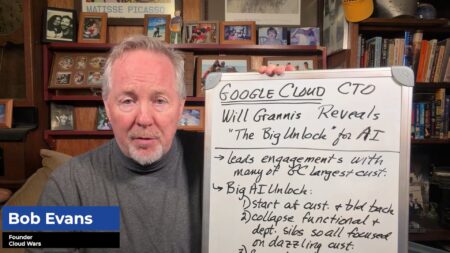Two days ago, Microsoft CEO Satya Nadella and CFO Amy Hood revealed to the world in unmistakably clear language why Microsoft has become, without question, the world’s largest and most-influential enterprise-cloud provider.
On my weekly Cloud Wars Top 10 rankings, Microsoft is #1 and has held that top spot over #2 Amazon for more than 2 years. In 2019, lots of folks ridiculed my positioning of Microsoft above Amazon, but since then I suspect most of them have seen the light.
Seeing the world through customers’ eyes
I’ll share a number of examples of how primarily Nadella but also Hood articulated that unique capability during the Jan. 26 fiscal-Q2 earnings call, but let me first offer it up in one strikingly simple observation made by Hood near the end of the call.
Describing Microsoft’s rationale behind its strategy and product portfolio, Hood said, “It’s how the customers see the solution.”
Here’s the larger context in which Hood framed that comment—a real 2×4-across-the-face bit of clarity in an industry dominated by vendor-speak—as she was discussing how Microsoft looks at enterprise apps in a unique way.
And be sure to note how Hood cites the company’s overarching “commercial cloud as our frame.”
One of the exciting parts about Dynamics is the expansiveness of that redefinition by industry. And even the terms and categorization today that I find that define biz apps, I think, we’ll see are quite large and will be addressed not just with our Dynamics product portfolio, but partially with our LinkedIn portfolio, with our Power Platform portfolio, with Microsoft 365 as well as Azure.
Thinking about it holistically is why it’s so important for us and why we keep coming back to the commercial cloud as our frame. It’s how customers see the solution. It’s how we sell, and it is how solutions are actually implemented for business process change.
Great lesson for tech companies
Now, it’s one thing for tech companies to map what they do to “how the customers see the solution”—although I’d contend that while most tech companies do a good job of saying that, not so many do such a good job in actually walking that talk.
But even for those that do operate that way, the striking advantage that Microsoft has created is the sheer breadth, depth, and relentless expansion of the products and technologies and services it can bring to bear to deliver on that “holistic” perspective cited by Hood.
And that is the context—unmatched breadth of offerings—in which Nadella framed almost all of his comments on the call, both in his opening remarks and in the Q&A portion with financial analysts.
Here are a few examples of Nadella driving home that message of (1) seeing the world as customers see it, and (2) then giving customers a seamlessly united set of end-to-end solutions to achieve the digital transformation they need.
The “dawn of a second wave of digital transformation”
After saying “hello” to everyone, Nadella got right to the point.
“It was a record quarter, driven by our commercial cloud, which surpassed $16 billion in revenue, up 34 percent year over year [32% in constant currency]. What we are witnessing is the dawn of a second wave of digital transformation sweeping every company and every industry.
“Digital capability is key to both resilience and growth. It’s no longer enough to just adopt technology: businesses need to build their own technology to compete and grow,” Nadella said. (In that specific context, he later added, “We are empowering domain experts, enabling anyone in an organization to build applications, automate processes, create virtual agents, and analyze data.”)
Nadella then laid claim to being the #1 cloud company in the world.
“Microsoft is powering this shift with the world’s largest and most comprehensive cloud platform.”
Azure’s impressive depth and breadth
And he then went on to outline that full-stack innovation:
- “Azure as the world’s computer”;
- hybrid computing, where Microsoft is “accelerating innovation to meet customers where they are”;
- digital twins;
- industry clouds;
- an expanded relationship to help SAP move production workloads to Azure;
- the data layer with the “unlimited” Synapse database;
- the new Azure Purview solution for data governance;
- Microsoft’s massive AI assets and solutions;
- its intimate and front-edge engagements with developers via GitHub;
- the fast-growing Power Platform to help customers accelerate tech intensity;
- the rapidly expanding and fast-growing Dynamics 365 family of enterprise apps;
- LinkedIn’s unique capabilities, which are being more deeply integrated with everything from Dynamics to Teams and beyond;
- the Teams juggernaut powering huge growth in Microsoft 365; and
- while it’s hard to believe a $10-billion business growing at 40% would be left for last, Microsoft’s wide-ranging cybersecurity offerings.
Growth drivers for Azure
In the Q&A portion of the call, Nadella was asked to outline the drivers behind Azure’s 48% revenue growth in Q2. And in replying, Nadella immediately came back to the big-picture story of the depth and breadth and interconnectedness of Azure and the Microsoft Cloud.
“I would say again with Azure, some of the core differentiation we have when it comes to our hybrid leadership, some of the new data products that are highly differentiated and competitive in the marketplace, as well as the integration with every other layer of our stack, whether it’s the dev layer with Power Platform, or GitHub, or with Teams to Power Apps to Azure DB, or the industry solutions we now have in healthcare and in retail.
“They are all leading to that time to value, the price differentiation and cost advantage to customers, and most importantly, agility in their ability to build their own digital capability.
“All the parts coming together”
“So that’s what you see in the acceleration around Azure. But when we think about Microsoft Cloud, we think about all the parts coming together to deliver value and differentiation to our customers.”
That’s the key point, isn’t it: “We think about all the parts coming together to deliver value and differentiation to our customers.”
Or as Hood expressed it, “It’s how the customers see the solution.”
Let me offer one more example, and on this one I’ll include the question from an analyst because I think it’s important to see how the frame of reference of the analyst is so conditioned to the present or even the past—narrowly defined islands of IT products—while Nadella’s vision is far more expansive and customer-centric.
Analyst Walter Pritchard of Citibank asked, “Question for Satya in how you’re thinking about the $200-billion enterprise-applications market. Your market share in that area is fairly low in aggregate. You’ve got Dynamics that’s performing really well and sounds like it’s accelerating. Just wondering how you’re looking at that market more broadly as an opportunity for the company.”
And here’s Nadella’s perspective-shifting reply.
Narrow view versus more-expansive view
“Yeah, we’re very, very focused on what we think of as modern business-process applications, Walter,” Nadella said, clearly differentiating his view of “modern business-process applications” from Pritchard’s “enterprise applications.”
“The way I look at it is there’s a complete rethink on even if you take the previous conversation around what are the workflows that need to get integrated into a communications tool such that there is real continuity between frontline to knowledge worker to business process. I think that opens up a ton of opportunity,” Nadella said, warming to the subject.
“I mean, take something like even digital twins and the level of automation that one can bring even into manufacturing. So the combination of an Azure PaaS to SaaS capabilities in Dynamics 365 can be very transformative to digital manufacturing, which is probably going to be one of the bigger trends going forward. Same thing in supply chain.
“So it’s a pretty important area for us with our participation in business-process applications coming on the Azure side, on the data side, on the AI side, on the biz apps side, as well as on Power Apps.
Thinking like a customer, not a vendor
And then Nadella evangelized the need for the entire industry—vendors, analysts, partners, everyone—to stop seeing the tech business as it used to be and instead view it as it is becoming.
“So it’s not one narrow category, because I think the way you measure business applications and the categories of business applications is pretty narrow.
“The business process is much broader than that.”
Get that? The industry thinks in terms of “business applications” but the customers are concerned with “business process.”
Simple?
Obvious?
Easy?
Yeah, maybe.
But maybe not.
And maybe it’s why Microsoft just posted the greatest quarter in the history of the enterprise-tech business.
RECOMMENDED READING
IBM Shocker: Q4 Cloud Growth Plummets to 8%
Google Cloud Seeing “Extraordinary” Demand for Multicloud “Anthos,” Says CEO Kurian
Oracle CEO Safra Catz: 10 Predictions for Fast-Growing Cloud Business
Inside World’s Hottest Cloud Vendor: a Chat with Google Cloud CEO Thomas Kurian
While Oracle, SAP and Salesforce Snub Co-CEO Model, Workday’s Loving It
Is SAP Ready to Drive the Digital Revolution? An Exclusive Chat with CEO Christian Klein
How Microsoft Plans to Stay #1 in Cloud: Exclusive Interview with Exec VP Scott Guthrie
Workday’s Aneel Bhusri Unplugged: Riffs on Employee Well-Being, UIs, and Rise of the Corporate Soul
Bill McDermott Exclusive Interview: ServiceNow Will Lap Legacy ‘Cement Makers’
Can Oracle Beat AWS and Snowflake in the Cloud Database Wars?
Subscribe to the Cloud Wars Newsletter for in-depth analysis of the major cloud vendors from the perspective of business customers. It’s free, it’s exclusive and it’s great!








